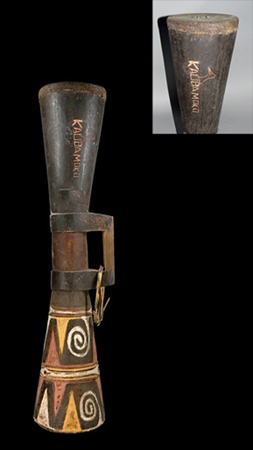
Owner: HWMC
Catalog#: 2OC-MBST-08
Provenance: Acquired by Marc Seidler ca. 1983
Struck Membranophones
South Papua ‘Marind-Anim’ Drum
South Papua, New Guinea
Marind-Anim (Anim means ‘people’)
Wood, reptile skin, pigments, fiber
ca. mid-20th century
Length: 44.5 in; Diameter: 9 in
Membranophones – Directly Struck
This single-head drum was made by the Marind-anim of New Guinea in the province of South Papua, Indonesia. It has an hourglass form with a rectangle shaped handle set in the middle. The size of these drums varies and this one is quite large at 44.5 inches tall and 9 inches wide. The lower section is decorated with curvilinear designs and the typical triangular and spiral designs painted red, yellow, and white pigment. On the upper section the word ‘Kaubamoko’ and the outline of a bird is incised. The bird image is possibly the Raggiana bird-of-paradise, also known as Count Raggi’s bird-of-paradise, a large bird in the bird-of-paradise family Paradisaeidae. It is distributed widely in southern and northeastern New Guinea, where its name is kumul. It is also known as cenderawasih. The skin of the drumhead is that of an iguana, affixed to the top with a mixture of lime, blood, and urine.
Eight tiny balls are found on the drumhead placed in a square. These balls are of the viscous substance which a particular kind of spider secretes in its abdomen for making its web. The function of the balls attached to the drumhead is to improve the sound. Should the drum become slack while playing it, the tuning or tightening of the tension of the drumhead, is achieved by warming it over a fire.
The Marind-anim live in South Papua, Indonesia. They occupy a vast territory, which is situated on either side of the Bian River. In the past, the Marind were known for their headhunting that was aimed at other tribes. During the 20th century their culture underwent major changes when the Dutch colonial administration forbade their ritual practices. Christian missions and the introduction of schools was used to assimilate the people to western culture.
Resource: https://drummuseum.com/New-Guinea/marind-anim-drum-new-guinea3.html
